|

Introduction
With nForce having been around for a little while but not in serious quantity, we were eager to get our hands on a board. MSI were happy to oblige with a full retail box of their nForce offering, the K7N420 Pro. NVIDIA have really pushed the boat out with their debut PC chipset and have come along way from the old Riva boards and partnership with SGS Thompson.
Before we take a look at MSI's twist on the new chipset, lets take a brief look at the chipset itself. Like most current chipsets, NVIDIA has split the tasks up between 2 chips, the IGP and MCP. Analogous to the north and south bridges we are used to discussing, each chip handles a different part of the system.
First up, the IGP. The IGP is the Integrated Graphics Processor and the 'northbridge' of the system. It's made up of 4 main component parts.
- TwinBank Memory Architecture
- Dynamic Adaptive Speculative Preprocessor (DASP)
- Integrated GeForce2 Graphics Core
- AMD Hypertransport Memory Interface
Taking a look at each component in turn we have TwinBank first. TwinBank is NVIDIA's patent pending memory controller that provides access to main system memory for the CPU, onboard GPU and audio processor in the MCP. With two memory slots filled the IGP offers 4.2Gb/sec of memory bandwidth shared simultaneously between the devices. Currently TwinBank provides a DDR memory interface so it's fully compatible with all the DDR memory technologies available at the moment. It's also designed to be scalable so it will remain compatible with future memory technologies.
The DASP is a technology that works to help reduce the bottlenecks that exist between CPU, main memory and the graphics and audio subsystems in an x86 design. It stores data and instructions that it thinks will be needed next by the system.
The integrated GeForce2 core speaks for itself. Rather than living on it's own card, NVIDIA have integrated an entire GPU onto the northbridge silicon. It may not be world beating technology now, but the GF2MX core still holds its own in the majority of graphics applications. NVIDIA helps things along with an 8X AGP interface and while it's no GeForce3, it's still the worlds fastest integrated graphics solution.
AMD Hypertransport is AMD's 800Mb/sec I/O bus solution, much like VIA's V-Link bus and the hub bus system Intel use. It's used on the nForce to communicate with the MCP.
Here are the technical highlights of the IGP.
TwinBank:
- Integrated 128-bit Memory Controller
- Concurrent Simultaneous Access for IGP, MCP and CPU
- Supports 2.5V DDR SDRAMs
DASP:
- Enhances CPU performance
- 8-way Prediction of Memory Accesses
Integrated GPU:
- Two Pixel Pipeline
- NVIDIA Shading Rasteriser (NSR)
- 2nd Gen NVIDIA TnL Engine
- Cube Mapping
HyperTransport:
- 800MB/sec transfer rate
- Low Voltage Differential
- Low Pin Count
The IGP also has a number of small but key features in the nForce technical specification. These include a TV Encoder interface and a DVI interface that runs simultaneously with the CRT output and supports the full DVI spec.
The MCP is a similar technical tour de force. The Media Communications Processor packs a complete advanced audio processor along with a 100Mb/sec Ethernet interface onto its silicon. It's also the provider of the HomePNA 2.0 interface, the USB ports and the IDE interface (ATA100). It uses HyperTransport to communicate with the IGP and it gives the audio processor quick access to the CPU and system memory.
The APU (Audio Processing Unit) is the same APU in the XBox. DirectX 8 is fully supported as you would expect and the hardware is capable of some cool stuff including 6 speaker output and a full Dolby 5.1 hardware implementation.
NVIDIA call their Ethernet technology StreamThru and claim it offers speedups in applications where the data is being streamed to and from the port at high rates.
That's the feature set taken care of. We can see NVIDIA have tried to integrate as much as possible onto the IGP and MCP while at the same time going for a 2 chip approach so they can upgrade key areas without needing to redesign the whole chip had it been a single chip design.
MSI are one of the brave few to have come up with a shipping nForce design so lets take a look at how they've implemented things.
MSI K7N420 Pro
The K7N420 as the name suggests is based on the 420D nForce that we've just discussed with full onboard graphics, sounds and ethernet. So we have the full IGP and MCP along with the following.
- 3 DDR DIMM slots for up to 1.5GB of memory
- 1 x AGP slot (2x/4x and 1.5V only)
- 5 x PCI (32-bit PCI 2.2, 3.3/5V)
- 1 x CNR (communications network riser)
- 2 x IDE ports for 4 devices up to ATA100
- 2 x serial (1 header) and 1 x ECP/EPP parallel port
MSI have used an Award BIOS to provide full Plug & Play support and allow chipset adjustment to tweak the board.
Bundle
MSI always impress with the actual bundle you receive when you buy their hardware. The presentation is Grade A with cool box art. Opening the K7N420 Pro box and you a greeted with a plethora of items. You get the extra USB ports, the D-Bracket (more on D-Bracket soon), the manual, a little MSI sticker and of course the board itself. Shipping boards will also come with the always excellent MSI CD. In the review sample there was the nForce reviewers guide and nForce technical CD from NVIDIA. Then you have the board itself resplendent in smoked antistatic bag. As always from MSI, a quality bundle.
A quick word on D-Bracket for those that don't know what it's about. It's basically a set of 4 dual colour LED's mounted on a back plane. The LED's change colour depending on what stage of the boot process the board is in, culminating in full green for a successful boot. Epox do something similar with dual digit panel on the corner of their recent board. MSI move the diagnostics to the outside of the case however and let you take a peek at system status without having to remove case panels.
Lastly, I'm not sure if shipping K7N420 Pro's will come with SmartKeq, MSI's USB security device as the review sample didn't.
Layout
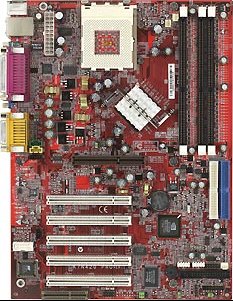
As we can see from the shot above, the MSI has a fairly standard layout. Lets start at the top left as usual and work our way down. First off we hit the vertical ATX connector just off the top edge in a nice placement. The socket is in the normal place in the default orientation with plenty of room around it. 2 fan headers are next and on the far right we hit the 3 DIMM slots. Nothing exciting so far.
Moving down we hit the nForce IGP (Northbridge) and it's clever heatsink. The chip is rotated 45 degrees from the norm which helps shorten the traces slightly between the IGP and it's connected components. The heatsink has clip design that I've seen on recent Pentium 4 motherboards. It's a Z shaped clip and is easily removed to allow you to replace the sink, apply better thermal compound etc. While I don't see a market for after market northbridge sinks, it's a simple, easy clip design that's better than push pins. While it's not usually required that you remove the sink on the northbridge, for those that have to, the clip makes it simple. I've heard some people claim that the rotated chip takes up more room on the board but what else is there that should be in that area?
Carrying on down we hit the AGP slot, the PCI slots and the MCP (southbridge). The IDE ports are right aligned and vertical and the floppy port is near the bottom and horizontal. I dislike the horizontal layout for floppy/IDE and it's exaggerated when it's too far down the board. However, provided you floppy cable is long enough there shouldn't be a problem.
Just above the floppy port we have the USB headers for the extra ports. The D-Bracket and SPDIF header for the APU are all in logical places.
Overall, another sound layout from MSI. Similar to the NVIDIA reference design which isn't a bad thing. It's also nice to see MSI's usual red PCB making an appearance.
Performance
We'll be using the same test software as previews reviews plus we're adding a further benchmark into the mix, Aquamark v2.3. Aquamark is based on Aquanox, the underwater game from Massive. I was lucky enough to see Aquanox at The Gathering NVIDIA developers event earlier this year while it was still in development. It makes heavy use of pixel and vertex shaders to achieve it's effects. We'll be using that to replace Unreal Tournament as our DirectX game benchmark due it's use of the current DirectX version, DirectX 8.
With the nForce being such an unusual beast, we'll take a look at benchmarks from a few perspectives. First off we'll test with a Ti500
installed, the onboard graphics core unused and the system at stock speeds with no overclocking. Then we'll remove the Ti500 and test the GeForce2 MX core. Finally we'll try our hand at overclocking on the MSI and have a quick look at TwinBank and it's effect on things.
You have a selectable frame buffer size from the BIOS for when you use the integrated graphics core. It was set to 32Mb throughout the review.
The test system.
- MSI K7N420 Pro AMD Socket A Motherboard (NVIDIA nForce Chipset)
- AMD Athlon XP1500+ (1333Mhz)
- 2 x 256 Crucial PC2100 DDR memory modules
- MSI G3Ti500 Pro Graphics card (GF3 Ti500, 64Mb)
- Adaptec 39160 PCI SCSI Dual Channel U160 controller
- 2 x 73Gb Seagate Cheetah U160 10,000rpm SCSI disks
- Plextor 12/10/32S SCSI CDRW
- Creative 12x IDE DVD
I also used a Netgear FA310TX PCI NIC in the system too which will be explained later.
Software Versions.
- Windows XP Professional Build 2600.xpclient.010817-1148
- DetonatorXP 22.40 NVIDIA drivers
- 5.10.2722.0 nForce drivers
- Aquamark v2.3
- Quake3 v1.30
- Unreal Tournament 436
- POVRay v3.1g.msvc.unofficial-win32 dated 28 August 2001
- 3DMark 2001 Professional
- SiSoftware Sandra v8.53.1.11
Stock Performance w/ NVIDIA Ti500 graphics card
First up, the three sandra tests, CPU Arithmetic, CPU MultiMedia and Memory Bandwidth.
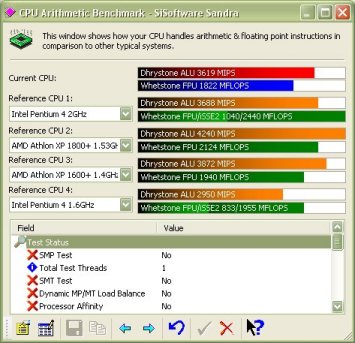
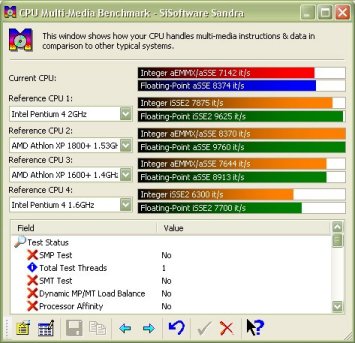
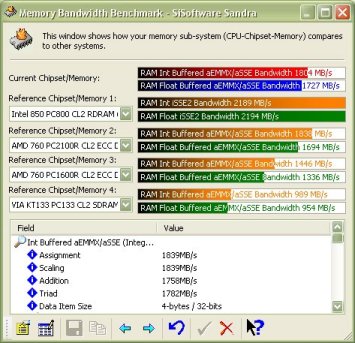
We'll gloss over the CPU results since they are normal and show nothing of real interest. The memory benchmark is interesting with the nForce being a new chipset. The version of Sandra used doesn't have the nForce as a reference chipset to choose from when taking the compare screenshot. I seem to remember nForce numbers in a previous beta of the new Sandra however they are strangely absent from the test version. Bear in mind that TwinBank was operational so the chipset was operating as fast as it was capable of.
NVIDIA claim 4.2Gb/sec in TwinBank mode according to the NVIDIA literature and MSI press kit that accompanied the board on it's travels to me. Remember that given the FSB of the processor and the fact that the processor at 133Mhz FSB can only make use of half that theoretical bandwidth when transferring to and from the IGP and the Sandra numbers begin to make a bit more sense.
Approximately 85% bandwidth utilisation at stock speeds is quite impressive, especially from a debut chipset from a manufacturer that previously only had expertise at making graphics cores. A nice first showing from the chipset indeed.
Before we hit the game benchmarks lets take a look at POVRay. It's a CPU test and basically confirms what you see in Sandra, that things are performing as expected.

The render time using the same binary and scene for a 2Ghz Pentium 4 on an i850 platform (20 x 100, RAMBUS @ 400Mhz) was 55 seconds. Compare that to 54 seconds on our test system and we can see the AthlonXP flexing it's muscles. Considering the CPU is clocked 1.5x slower than the P4 you can see how the increased IPC of the AXP gives the processor a real world advantage over the P4 at significantly slower clocks. While POVRay isn't a chipset stresser, it does show the nForce driving the CPU properly.
We'll start with 3DMark 2001 now we have the non game tests out of the way.
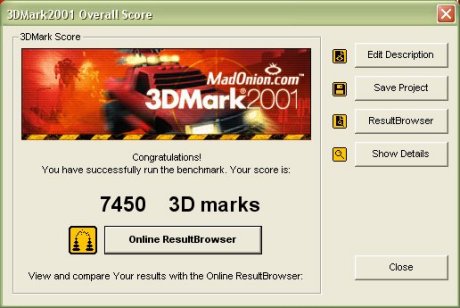
Given that the extra clocks on the Ti500 compared to a stock GF3 account for around 200 points we can see that in 3DMark performance, the nForce, XP1500, Ti500 combo performs roughly similar to a P4 2GHz (15 x 133) with a GF3 on i850. That combination scored 7294 in our recent Asus P4T-E review. Given the chipset, CPU and card, we could maybe have expected another 100 points or so from a default run with no tweaks. ~7500 out of the box is not to be sniffed at. Only our R8500 on a 2Ghz P4 has scored more out of the box untweaked (~8000).
Aquamark makes its debut in a Hexus review today and it's a nice text of the pixel and vertex shader power on a graphics card. Based on the underwater game of similar name from Massive, Aquanox, it shows a quick run with as many effects used as possible.
AquaNox - AquaMark V2.3 2001/11/20 - (c) Massive Development
------------------------------------------------------------
RESOLUTION : 1024x768x32
FSAA : NONE
PIXELSHADER: YES
TEXTURE : 24MB
SECONDS : 49.25
.......
MIN FPS : 28.1
MAX FPS : 61.5
AVG FPS : 45.8
There we can see the actual output from the program. While we have no formal scores from other test system on Aquamark since it's making its debut here I did a quick run on a 1.5Ghz AXP, KT266A and stock clocked GeForce3 (200/460) and it scored 45.6 AVG FPS with the same settings. We can see slower CPU clock and higher GPU clocks of the nForce system being evened out by a higher CPU clock and lower GPU clocks on the KT266A system.
Quake3 v1.30 performance is next.
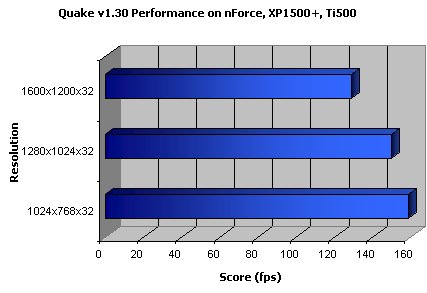
Only at 1600x1200 does Quake3 become GPU bound on the test system. Increasing card clocks at the higher resolution would have a large effect on the scores as the raw fillrate of the card comes into play. Respectable scores from the test system. Even with such a 'slow' CPU in terms of the CPU's available today, the nForce, XP1500 and Ti500 combo scores well enough in Quake3 to be playable at even the highest resolution we tested at. Given that 1600x1200 is a reasonable limit for the majority monitors on systems today, being able to play Quake3 without any problems in 32bit colour with all high performance rendering options turned on shows us how far
today's systems have come when asked to play today's games. Any new desktop systems sold today should be able to cope with all current games with no problems at all.
Stock Performance w/ Onboard NVIDIA GeForce2 MX core
Before we start with the numbers, a quick note on running the onboard graphics at high
resolution, at 1280x1024 at anything other than 60Hz refresh, the focus was horrible. My monitor is a nice sharp Sony G400 19" CRT and using the Ti500 is a pleasure at 1280x1024x32 @ 85Hz. It's nice and bright and has zero focus problems. The same resolution at refresh using the onboard core was a mess. My eyes took about 2 minutes to tire.
Dropping to 1024x768 helps things a lot but there is still a hint that the display is out of focus. It's nice and bright, but the focus is gone. The Ti500, Radeon 8500 and 7500 all are fine on my Sony. The image quality of the onboard core is the worst I've seen in a long time, especially at high resolution. I hope it's fixable and just a one off on my review board.
Again, we'll kick off with the 3 Sandra benchmarks.
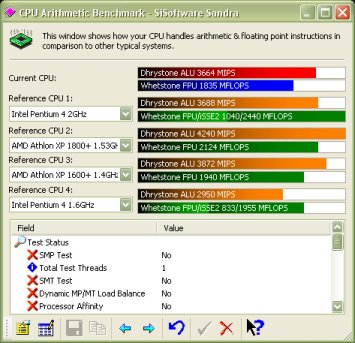

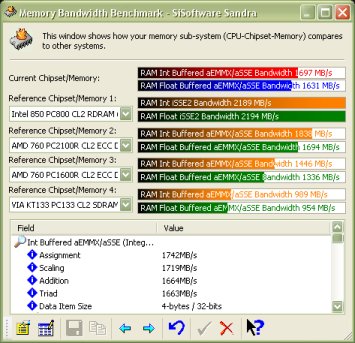
The two CPU benchmarks are only there for completeness. Skip over them and concentrate on the memory benchmark. Notice how we lose 100Mb/sec roughly when using the onboard core? There is a definite memory bandwidth penalty when using the onboard graphics. I assume this is because the core uses main memory as display memory and there is a constant transfer happening to main memory rather than card memory when using the integrated core.
Next up, POVRay.

Here we see a 1 second advantage compared to when the Ti500 was used as the display device. Nothing to be alarmed at. As always, the POVRay results are a run of 5 and the average time is used as the result.
Now onto the game benchmarks where we can see the integrated core in action, starting with 3DMark.

We lose 5000 points straight off by using the integrated core rather than a stock clocked GeForce3 Ti500. Being a GeForce2 class GPU means the integrated core has no pixel or vertex shader support. That means no Nature test which is a big 3DMark points gain for cards that can run it. The rest of the points difference is down to the slower clocks, lack of dedicated, highly clocked DDR display memory and lack of core enhancements like the LMA crossbar that arrived with the GF3.
Lets face it, the GF2 isn't a high performing graphics solution compared to the current leading edge consumer cards. However, the score of 2316 is similar to the score achieved by the overclocked Abit Siluro MX400 on a 1430Mhz AMD Thunderbird Athlon CPU that we used back in out MX400 shootout. Consider that the integrated core here on the nForce is clocked a fair bit slower (175Mhz) and it becomes more impressive. Also the AGP bus when using the integrated core was 100Mhz rather than the usual 66Mhz and a 32Mb framebuffer was selected in the BIOS.
Onto Aquamark.
AquaNox - AquaMark V2.3 2001/11/20 - (c) Massive Development
------------------------------------------------------------
RESOLUTION : 1024x768x32
FSAA : NONE
PIXELSHADER: NO
TEXTURE : 24MB
SECONDS : 209.59
......
MIN FPS : 5.8
MAX FPS : 31.4
AVG FPS : 10.8
We lose 35fps here, again due to the slower clocks, reliance on slower display memory and lack of vertex and pixel shader capability. Watching the test was painful after watching it glide on the Ti500. Proper DX8 games that use the shader functions aren't going to run particularly well on the integrated core.
Finally, Quake3.
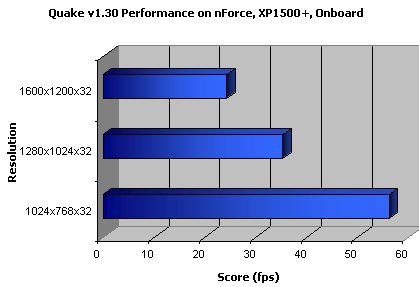
Here we are losing over 100fps each time to the Ti500. The same reasons apply, minus the excuse about the lack of pixel and vertex shaders. Increased core clock, core enhancements and fast DDR display memory all give the GF3 Ti500 the speed win in this case.
So we've seen that the integrated core isn't a GF3 beater. That's to be expected given the class of GPU it is and the memory it has to work with. So we can write it off as a world beater in performance terms, but we shouldn't write it off in the area that it's designed for.
It's still the quickest integrated graphics solution available today. Check out the numbers again. Quake3 at 1600x1200x32 manages 22fsp on the 1500XP+ but remember it's very high resolution, fillrate is kings and every performance sapping rendering option is turned on and suddenly the numbers
don't look so bad. With a quicker XP processor and a drop to 1024x768x32, the most common gaming resolution in use today and the IGP performs perfectly well. It's not the best GPU for running apps that perform well due to heavy use of hardware vertex and pixel shaders but it will serve very well for the time being. With the onboard AGP slot, you can use the IGP for the time being and make an informed choice a few months down the line after having disected the market at that time and having saved up the cash to buy a new card.
The nForce is a cash saving solution for upgraders. The IGP is the main reason. It allows solid gaming at decent resolution and provided, on the MSI at least, an upgrade path via the AGP slot.
Overclocked performance (or lack of it)
I had high hopes for overclocking the nForce. Installed in the socket is a special CPU from a special batch of XP1500's made in week 43. This particular CPU does 1.8Ghz at 1.85v where you can find a board capable of feeding it 180fsb due to it's unlocked state and 10x multiplier. With the lack of multiplier adjustment on the MSI you are limited to FSB overclocking so having an unlocked CPU makes no difference.
The Award BIOS however gives very little scope for fine tuning the FSB and extracting maximum performance. There are only a few limited FSB selections available. From 133Mhz up you only have 137, 140, 145, 147, 154 and 157 to choose from with each setting having 2 degrees of mem speed.
On this MSI I had big problems getting the system to boot at anything other than 137 or 140Mhz FSB. This was definitely not a CPU or memory issue. The CPU is a monster that will do nearly 1.7Ghz at default volts. The memory has run at 166Mhz+ in other motherboards and certainly does 150Mhz at default Vdimm meaning at least 147Mhz should have been achievable even allowing for the memory to give up the ghost after 150Mhz.
Relaxing CAS settings, choosing the lower DDR mem speed for the chosen FSB, increasing CPU Vcore to the maximum 1.85V all failed to help. What's more is that running Sandra at 137 or 140Mhz when the system seemed stable would immediately cause a BSOD inside the audio driver.
This MSI is definitely not an overclockers board. It's perfectly happy at 133Mhz FSB and the performance is great. However, at least on this sample, overclocking was pretty much a no go. Symptoms ranged from flickering green and pink BIOS screens, total video black out after SCSI BIOS init to complete instability.
Kyle and the gang over at the [H]ardOCP had better luck than me overclocking the MSI but didn't manage about 145Mhz FSB from what I can tell.
We'll hopefully revisit the board at a later date if we can pin down some elusive overclocked stability but until then I can't give you a full range of benchmarks due to the persistent BSOD's inside the audio driver. I could turn off the APU but if you're buying an nForce I'd hope you'd want to take advantage of the integrated options. Given the current high price of the boards, it would be silly not to. I'm hoping new nForce drivers and a BIOS update will wash the woes away.
A quick look at TwinBank
On the MSI, to take advantage of TwinBank you need a stick of memory in DDR3 and a stick in either DDR1, DDR2 or both. DDR3 is a single bank on it's own and DDR1 and DDR2 share a bank. For TwinBank to work you need to activate both banks.
So why enable TwinBank? Firstly, using a single bank limits your maximum memory bandwidth to 2.1Gb/sec which is fine you might think seeing as
though current AMD processors can only make use of 2.1Gb/sec maximum. However when you bring the IGP and APU into play that can both access main memory
simultaneously along with the CPU (remember the TwinBank discussion at the start of the review?) letting increasing the memory bandwidth above 2.1Gb/sec lets the CPU have a full 2.1Gb/sec if it needs it and lets the IGP and APU fight over the remaining 2.1Gb/sec.
So TwinBank is a win if you are using the integrated graphics core? Absolutely! Given that the IGP uses main memory as display memory it's wise to give it all the memory bandwidth possible. Not using TwinBank when using the IGP as your display device hurts overall performance. When not using the IGP it's not so much of a win. There is no way the CPU and the APU can eat the full 4.2Gb/sec even fully stressed on their own.
More memory is always a good thing however and with DDR prices on the rise, if you are buying nForce go ahead and take advantage of TwinBank and stick 2 modules, one in DDR1 and one in DDR3.
Sandra for me shows a 5% increase in memory performance when using TwinBank over a single stick. This isn't the huge increase people are looking for when enabling TwinBank but remember that the CPU at 133Mhz FSB can all make use of a theoretical maximum of 2.1Gb/sec, the maximum for a single channel. The 5% increase we can attribute to the IGP simply being more bandwidth
efficient when TwinBank is working. People looking for TwinBank scores greater than 21xx/21xx at 133Mhz FSB will be disappointed.
Conclusion
So what do I think of nForce? It has it's problems. The integrated graphics core is too slow for my liking and the visual quality at high resolution was fairly poor. I have the luxury of having access to the fastest consumer graphics cards on the market so a GF2 MX wouldn't be my choice.
Also, towards the end of the review process I upgraded the nForce drivers to the latest version from NVIDIA's press FTP site and the onboard Ethernet stopped working. The driver for it fails to load and reverting to an older driver doesn't help. A reinstall of XP should cure that however and it's the reason for needing a Netgear NIC as outlined in the system rundown earlier.
Overclocking also isn't an option at all, at least for me. It just didn't want to happen.
So why do I still think that the MSI nForce is the coolest motherboard I've used in the last 12 months? For starters the onboard audio has to be the best I've used including the C-Media CMI8738 on the MSI i850 I reviewed not long ago. NVIDIA really have pulled out all the stops when designing the APU. It's a quality piece of audio hardware. For my tired old speakers it just sounds better than any sound card I've had the pleasure to use.
Secondly, for a debut chipset the performance at stock speeds is excellent. Stick a fast AXP in the board and you've got performance for well into next year. NVIDIA really deserve a clap for their first chipset.
MSI also deserve a round of applause for not wimping out and actually providing the Ethernet header. I can see companies being tempted to leave it out but when it's right there on the silicon, why not use it? Makes sense and MSI have done the right thing. The layout is usual MSI quality. They are a bit conservative when it comes to tweaking their boards from the BIOS and maybe they'll come out of their shell with regards to that in the future.
At stock speeds the board has been nothing but stable. Not a single crash, BSOD or any anomaly at 133Mhz FSB, 266Mhz DDR and 66Mhz AGP. Everything has been perfect.
Price has to be one of the only major sticking points. nForce isn't hard to come by in the UK and prices are around the £200 mark.
Update!
The day after the review went up the board showed up at a few places in the UK at significantly less than the £200 I stated above. Our good friends VGI have it in stock as I type this at £142 here. You can get it for ~£150 from a few places in the UK now. For £150 the board is a bargain. This drop in price removes one of the bad points about the board and I now think the board deserves the Hexus Editors Choice award because of this.
Apart from that the nForce should make a very decent LAN board with it's integrated everything or an excellent high performance board if fitted with a nice graphics card. The onboard Ethernet and APU are top notch and should be taken advantage of to their full capacity.
I've really grown to like the MSI. It's the best board I've used in the past 12 months and I've had a few excellent boards. It just beats out the KG7-RAID in terms of my favourite board in the last year. With the speed of stock CPU's and graphics cards at the moment, the fact that the MSI is a poor overclocker for this reviewer doesn't matter. Put any AXP and a GeForce3 in and it will fly.
Top marks MSI for having the guts to use nForce in a shipping design and doing it well and top marks to NVIDIA for their debut chipset and their work with AMD in implementing HyperTransport and a Socket A design.
We are happy to give the K7N420 Pro the Hexus Editors Choice Award!

|

